My experience with cooking with fresh basil
- Fresh basil is best used raw or added at the end of cooking to preserve its vibrant flavor and aroma.
- Growing basil at home enhances the cooking experience and allows for convenient access to fresh ingredients.
- Careful handling and proper harvesting techniques, such as picking leaves in the morning and avoiding bruising, enhance the basil’s taste.
- Homemade pesto and Caprese salad are highlighted as favorite recipes that showcase basil’s unique flavor.
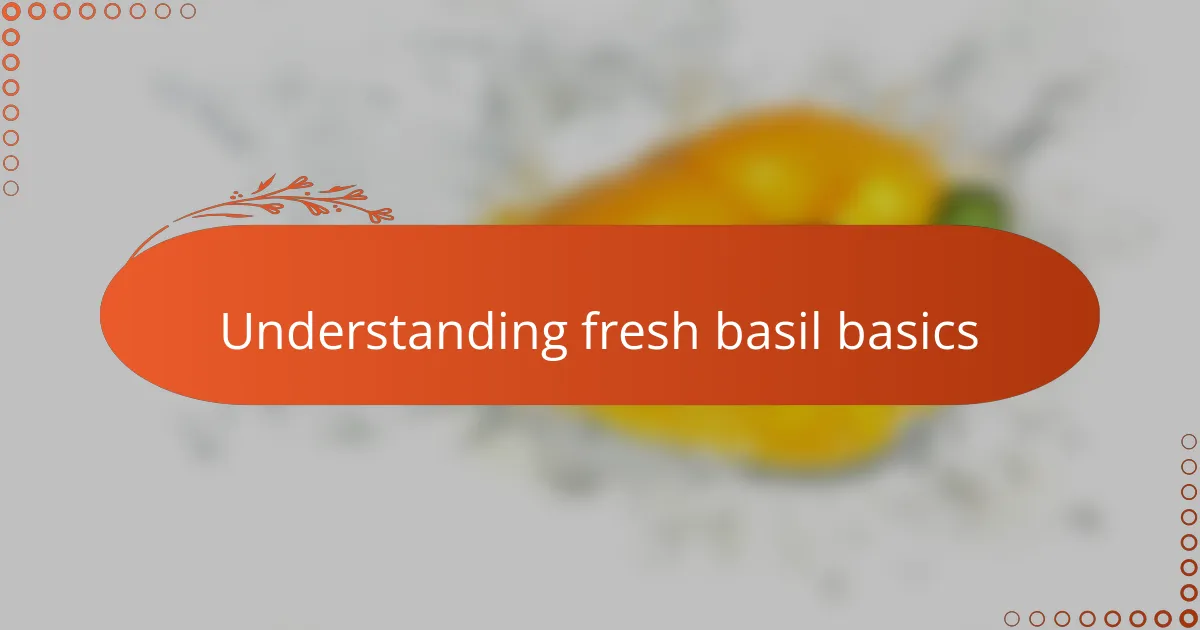
Understanding fresh basil basics
Fresh basil has this vibrant, sweet aroma that instantly lifts my spirits whenever I bring it into the kitchen. I’ve found that understanding its basics—like how delicate its leaves are and how easily they bruise—makes all the difference in getting the most out of it. Have you ever wondered why basil suddenly turns black when you cook it too long? That’s because its essential oils are quite sensitive to heat, and knowing this helped me adjust my cooking times.
When I first started using fresh basil, I didn’t realize how versatile it could be. Beyond just a garnish, it adds a fresh, peppery kick to sauces, salads, and even drinks. It’s fascinating how something so simple can transform a dish, but it all starts by understanding that basil’s flavor is best enjoyed raw or added at the very end of cooking.
Picking basil straight from the garden or farmer’s market always feels special to me. The bright green leaves signal freshness and promise a burst of flavor that dried herbs just can’t match. I’ve learned to handle those leaves gently and store them properly, which keeps their flavor intact longer—because fresh basil, when treated with care, truly elevates any homestead recipe.
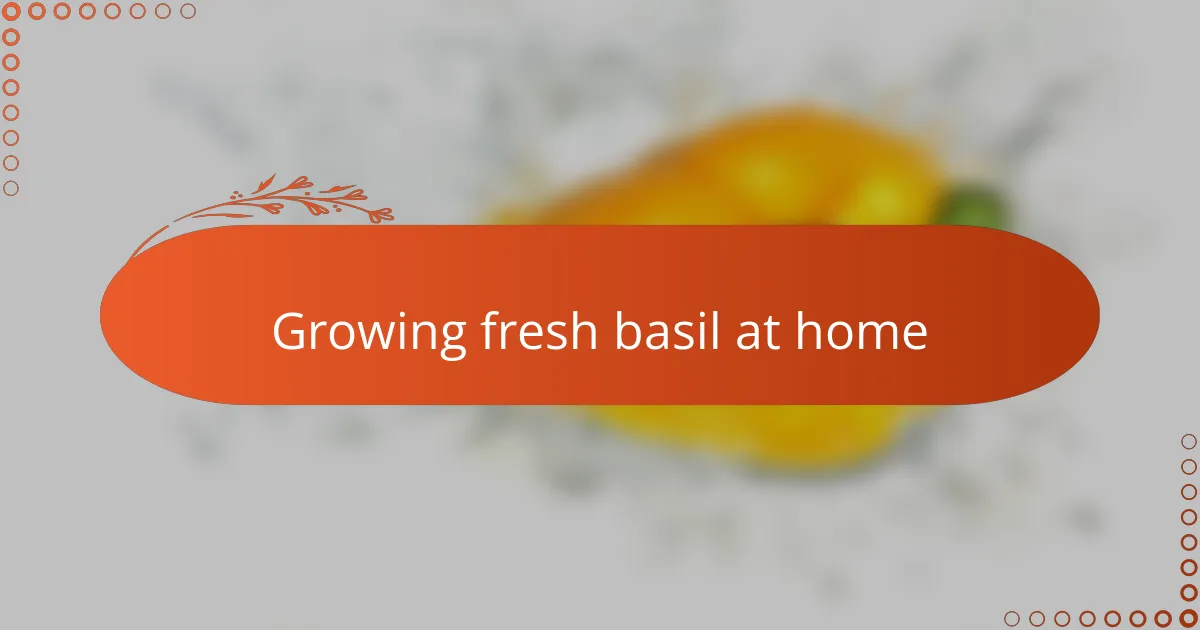
Growing fresh basil at home
Growing fresh basil at home has been a game changer for me. There’s something incredibly satisfying about snipping vibrant green leaves right outside my kitchen door whenever a recipe calls for it. It’s not just convenient—it feels like a small victory, cultivating a living ingredient that adds so much life to my dishes.
I remember my first attempt at growing basil indoors—I was surprised at how quickly it responded to a sunny windowsill and regular watering. It taught me to pay attention to little details, like making sure the soil drains well and pinching off flower buds to keep the plant producing lush leaves. Have you ever noticed how those tiny adjustments can make a huge difference in both growth and flavor?
What really stands out to me is how fresh basil connects me to the rhythm of the seasons. During summer, my plants seem to thrive and fill the air with their sweet aroma, reminding me of warm days and family meals outdoors. It turns cooking into an experience, not just a task—which is exactly why growing basil at home feels so rewarding.
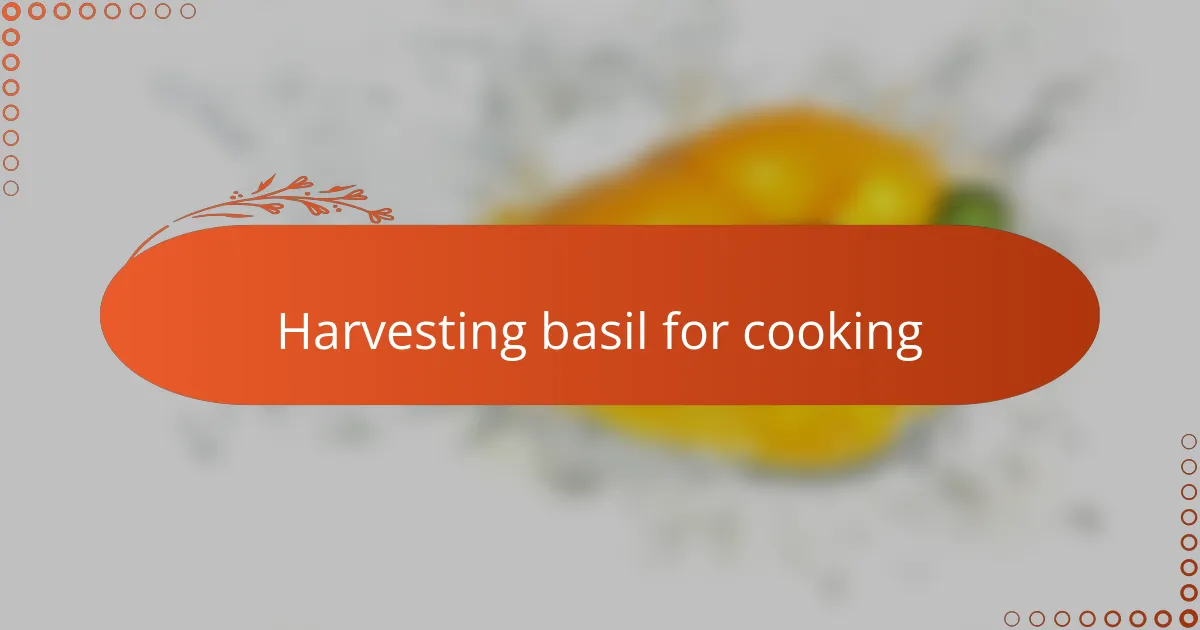
Harvesting basil for cooking
Harvesting basil has become a little ritual for me, one that I look forward to almost as much as cooking with it. I learned early on that the best time to snip the leaves is in the morning when the plant’s oils are at their peak, making the flavor more intense. Have you ever noticed how those freshly cut basil leaves almost smell like sunshine itself?
I remember the first time I clipped a handful of basil without damaging the plant—it felt like I was gathering a secret treasure. Cutting just above a pair of leaves encourages the plant to grow bushier, which means more harvests and more vibrant meals. This simple technique changed how I view harvesting; it’s not about taking, but about nurturing the plant so it keeps giving.
One thing I’ve come to appreciate is handling basil with gentle fingers. Bruising the leaves can turn them bitter or cause them to wilt prematurely, which is something I learned the hard way. Have you ever picked basil only to find it sadly blackened by evening? Now, I treat each stem like something delicate, and that care makes a real difference on the plate.
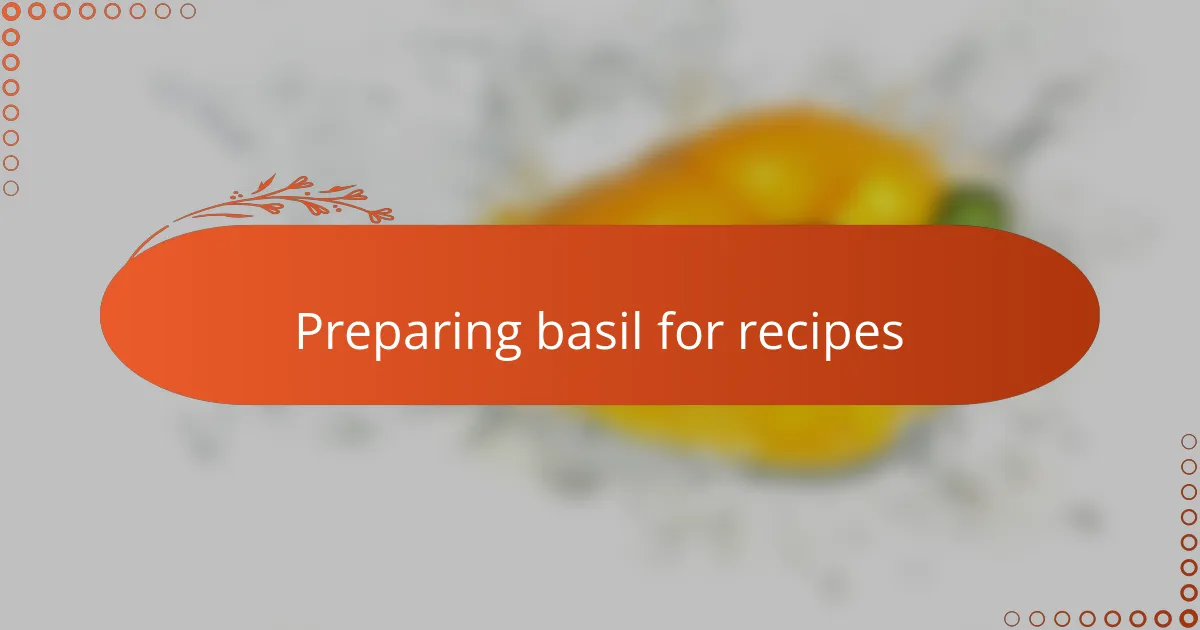
Preparing basil for recipes
Preparing fresh basil for recipes is a delicate process that I’ve learned to approach with patience. I usually start by rinsing the leaves gently in cool water, then patting them dry with a soft towel—too much moisture can make the basil soggy and dull its vibrant flavor. Have you ever tried cooking with wet basil? It tends to steam rather than sauté, which muffles that bright, aromatic punch I love.
When it comes to handling the leaves, I always tear them by hand instead of chopping with a knife. From my experience, tearing preserves the essential oils better and avoids bruising, so the basil tastes fresher and stays bright green longer. It’s a small step, but one that I swear makes a noticeable difference in dishes like pesto or fresh tomato salad.
Sometimes, though, I find myself pressed for time and need to prep basil quickly. In those moments, I stack the leaves, roll them into a tight cylinder, and slice them thinly—a chiffonade cut, if you want to get fancy. It’s an easy way to release the basil’s aroma without crushing it, and it always feels like a little kitchen victory when I sprinkle those delicate ribbons over my meal.
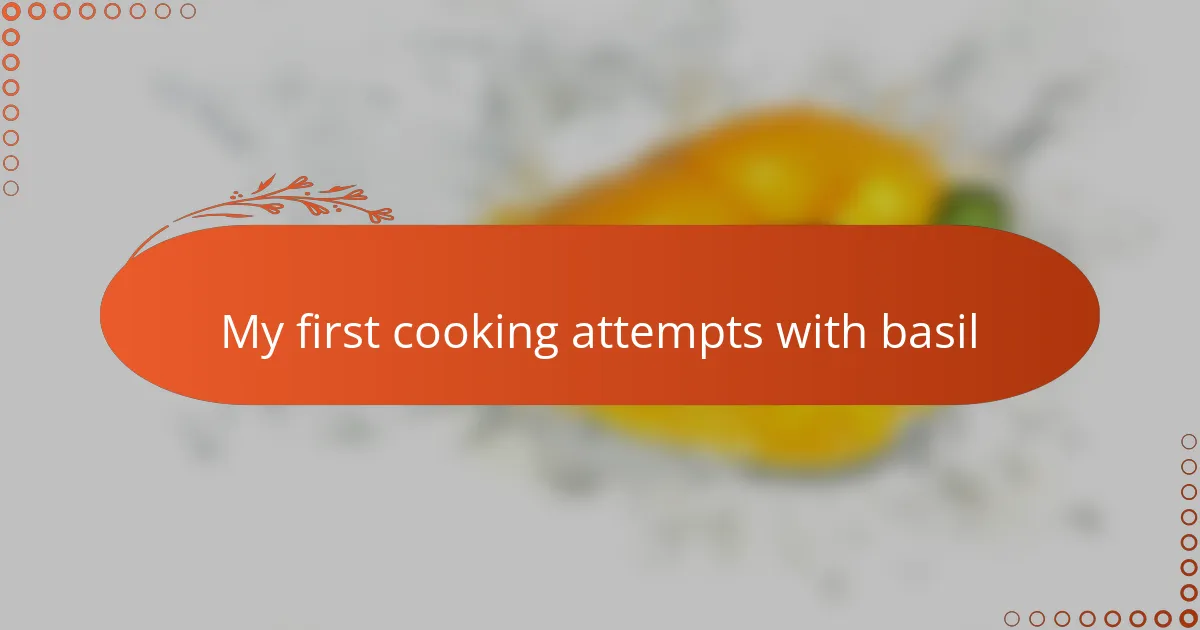
My first cooking attempts with basil
My first cooking attempts with basil were a mix of awe and a few small mistakes. I still recall the excitement when I tossed fresh basil leaves into a simple tomato sauce, expecting a burst of flavor. But then I overcooked it, and that vibrant green turned to an unappetizing dark—what a learning moment that was! Have you ever experienced that surprise when a fresh ingredient doesn’t quite behave as you imagined?
At one point, I tried adding basil too early into a hot pan, thinking more heat would deepen the flavor. Instead, the delicate aroma faded quickly, leaving the dish a bit flat. It was frustrating, but these early missteps taught me to be patient and add basil at the last minute, preserving that bright, fresh essence I love.
One of my fondest memories is the first time I made pesto from scratch using fresh basil I’d picked just hours before. The act of crushing those fragrant leaves with garlic and pine nuts felt almost meditative. It made me appreciate how fresh basil isn’t just an herb—it’s a little burst of summer and home on my plate. Have you tried making pesto fresh? It’s a game changer.
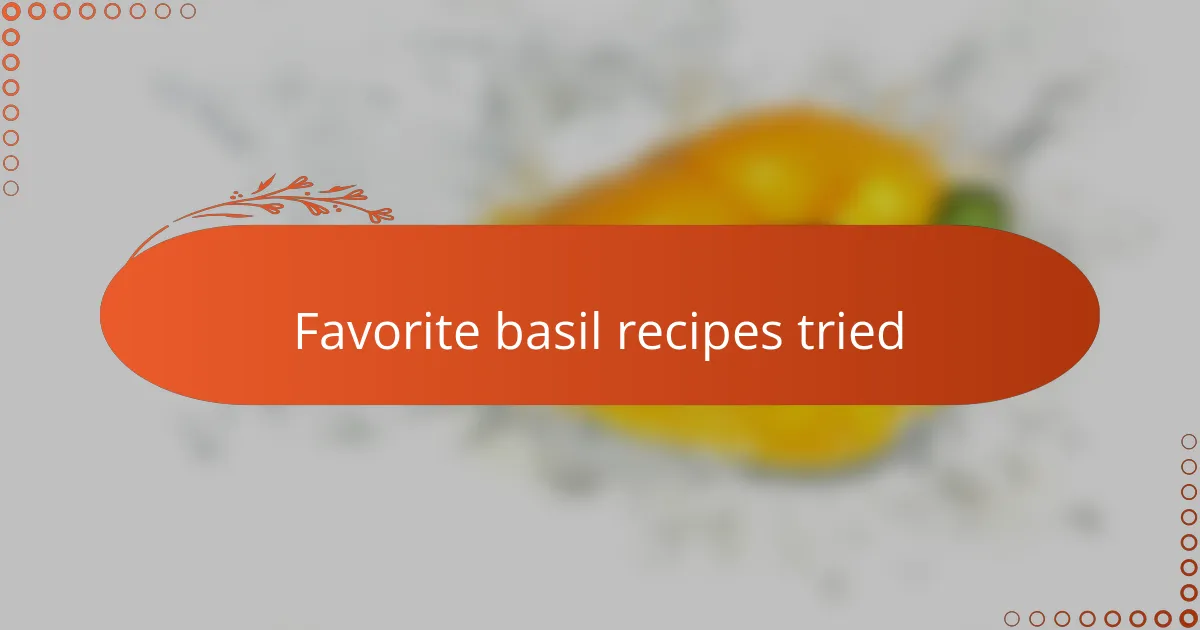
Favorite basil recipes tried
One of my all-time favorite basil recipes has to be homemade pesto. There’s something incredibly satisfying about grinding fresh basil leaves with garlic, pine nuts, and olive oil—it smells like summer in a bowl. Have you ever noticed how that bright, green pesto turns any simple pasta dish into a celebration of flavors?
I also love tossing fresh basil into a Caprese salad. The way the leaves complement ripe tomatoes and creamy mozzarella is pure magic to me. It reminds me of warm evenings spent enjoying garden-fresh ingredients with friends, where basil is the star even without cooking.
Sometimes, I drizzle torn basil leaves over a freshly made Margherita pizza just before serving. The contrast of the herb’s cool aroma against the warm tomato sauce and melted cheese creates a harmony I never tire of. Have you tried adding basil at the end? It keeps that fresh burst of flavor alive, making each bite a little moment of joy.
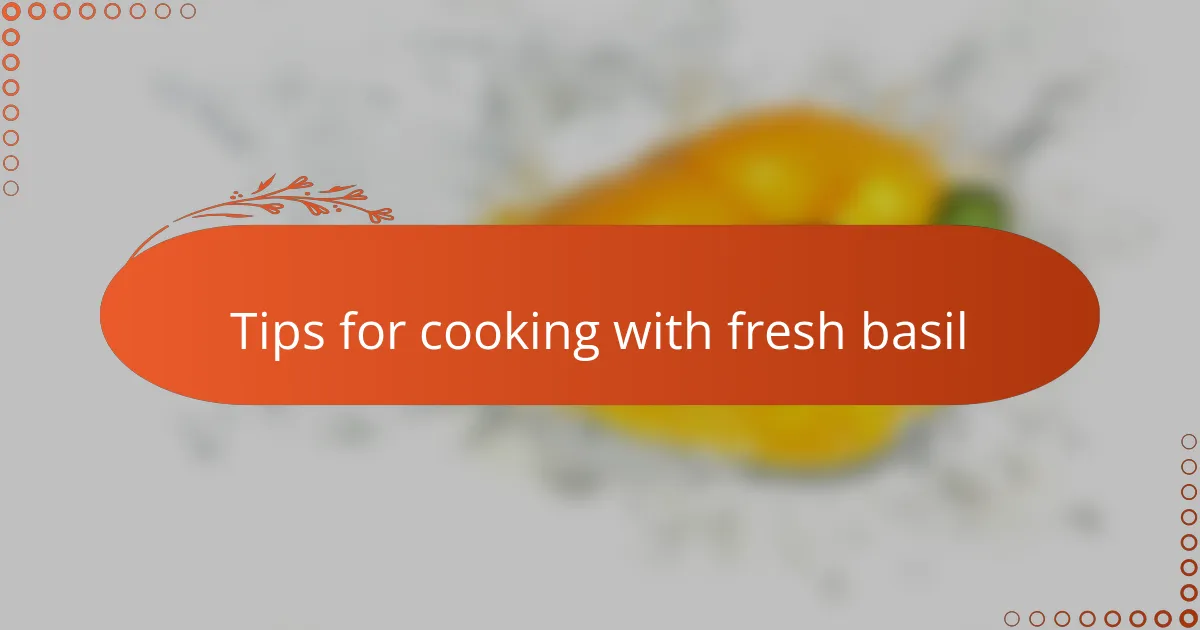
Tips for cooking with fresh basil
One tip I’ve discovered through trial and error is to avoid exposing fresh basil to prolonged heat. Have you ever noticed how quickly its vibrant green fades when cooked too long? Adding basil at the very end of cooking or as a fresh garnish preserves its bright flavor and aroma, which makes such a difference in the final dish.
Another little trick that has really worked for me is handling the leaves with care. I remember once rushing and chopping basil roughly, only to find the flavor muted and the herb looking wilted. Now, I tear the leaves gently by hand or use a chiffonade cut—this helps keep their oils intact and the taste fresh, which I think elevates any recipe noticeably.
Lastly, storing basil properly is key in extending its life and taste. I’ve found that treating basil like fresh flowers—standing the stems in water and covering loosely—keeps it lively for days. Have you tried this? It turns a quick snip from your garden or market into many more meals filled with that unmistakable basil freshness.
Source: https://thewannabehomesteader.com/my-experience-with-cooking-with-fresh-basil/
Anyone can join.
Anyone can contribute.
Anyone can become informed about their world.
"United We Stand" Click Here To Create Your Personal Citizen Journalist Account Today, Be Sure To Invite Your Friends.
Before It’s News® is a community of individuals who report on what’s going on around them, from all around the world. Anyone can join. Anyone can contribute. Anyone can become informed about their world. "United We Stand" Click Here To Create Your Personal Citizen Journalist Account Today, Be Sure To Invite Your Friends.
LION'S MANE PRODUCT
Try Our Lion’s Mane WHOLE MIND Nootropic Blend 60 Capsules
Mushrooms are having a moment. One fabulous fungus in particular, lion’s mane, may help improve memory, depression and anxiety symptoms. They are also an excellent source of nutrients that show promise as a therapy for dementia, and other neurodegenerative diseases. If you’re living with anxiety or depression, you may be curious about all the therapy options out there — including the natural ones.Our Lion’s Mane WHOLE MIND Nootropic Blend has been formulated to utilize the potency of Lion’s mane but also include the benefits of four other Highly Beneficial Mushrooms. Synergistically, they work together to Build your health through improving cognitive function and immunity regardless of your age. Our Nootropic not only improves your Cognitive Function and Activates your Immune System, but it benefits growth of Essential Gut Flora, further enhancing your Vitality.
Our Formula includes: Lion’s Mane Mushrooms which Increase Brain Power through nerve growth, lessen anxiety, reduce depression, and improve concentration. Its an excellent adaptogen, promotes sleep and improves immunity. Shiitake Mushrooms which Fight cancer cells and infectious disease, boost the immune system, promotes brain function, and serves as a source of B vitamins. Maitake Mushrooms which regulate blood sugar levels of diabetics, reduce hypertension and boosts the immune system. Reishi Mushrooms which Fight inflammation, liver disease, fatigue, tumor growth and cancer. They Improve skin disorders and soothes digestive problems, stomach ulcers and leaky gut syndrome. Chaga Mushrooms which have anti-aging effects, boost immune function, improve stamina and athletic performance, even act as a natural aphrodisiac, fighting diabetes and improving liver function. Try Our Lion’s Mane WHOLE MIND Nootropic Blend 60 Capsules Today. Be 100% Satisfied or Receive a Full Money Back Guarantee. Order Yours Today by Following This Link.






